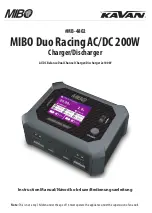
Charger Configuration
Installation and Configuration
CHG-75 PN 51315:A 08/01/01
11
2.3 Charger Configuration
2.3.1 SW2 & SW3 SLC Addressing Switches
An addressable monitor module has been incorporated into the circuitry of the CHG-75
to allow a host FACP (Fire Alarm Control Panel) to monitor the charger condition via
its SLC. This monitor module will create an open circuit condition when any local
charger trouble occurs. If AC power is lost, the monitor module will create a short
condition which will be seen by the FACP immediately, even if AC delay is enabled.
By addressing and connecting the charger to an addressable control panel’s SLC, the
panel can be programmed to monitor this module for activation.
Rotary switches SW2 & SW3 are used to address the CHG-75 for connection to the
addressable control panel’s SLC. The switches must be set to a unique address which
has not been programmed for any other device on the SLC
To set the desired address, turn switch SW2 to the
tens
digit of the address and SW3 to
the
ones
digit of the address. For example, to set the charger to address
125
, position
SW2 so the arrow points to
12
and position SW3 so the arrow points to
5
.
In the following example, the power supply has been set to address
68
, with SW2 Tens
switch pointing to
6
and SW3 Ones switch pointing to
8
.
2.3.2 SW1 SLC Communication Enable Switch
Slide switch SW1 is used to enable and disable the SLC communication between the
CHG-75 and the FACP. Positioning SW1 to the left (ON) will enable SLC
communication while positioning the switch to the right (OFF) will disable
communication. Refer to Figure 2.1 on page 10, for the location of switch SW1.
Note that if the FACP has been programmed to monitor the charger via the SLC,
positioning SW1 to the right (OFF) position will disable SLC communication between
the charger and control panel, causing the FACP to indicate a communication fault for
the charger address.
2.3.3 AC Loss Reporting Delay - Central Station Applications
If a Digital Alarm Communicator (DACT) is being used, the reporting of an AC loss
condition to a Central Station must be delayed. This will delay the activation of the
trouble bus and Form-C trouble contacts when the AC fails. The charger can be
configured for an 8-hour or 16-hour delay as follows:
1.
JP3
- Cut jumper JP3 to enable a delay in reporting AC loss
2.
JP4
- Leave jumper JP4 in to delay AC loss reporting for 8 hours
Cut jumper JP4 to delay AC loss reporting for 16 hours
Refer to Figure 2.1 on page 10, for location of the jumpers.
T E N S
O N E S
0
4 3
9
2
6
1
5
7
8
12
13
15
14
10
11
0
4 3
9
2
6
1
5 7
8
12
13
15
14
10
11
Figure 2.2 CHG-75 Addressing
SW2
SW3
chg75add.
cdr












































